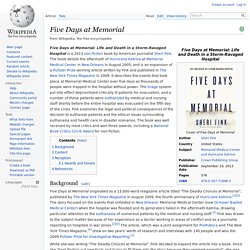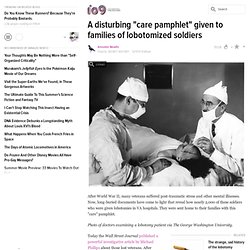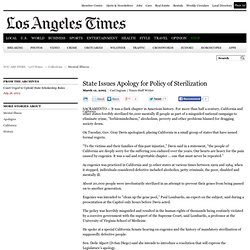

Five Days at Memorial. Five Days at Memorial: Life and Death in a Storm-Ravaged Hospital is a 2013 non-fiction book by American journalist Sheri Fink.

The book details the aftermath of Hurricane Katrina at Memorial Medical Center in New Orleans in August 2005, and is an expansion of a Pulitzer Prize-winning article written by Fink and published in The New York Times Magazine in 2009. It describes the events that took place at Memorial Medical Center over five days as thousands of people were trapped in the hospital without power. Nellie Bly. Early years[edit]

The First-Known Medical Consent Form Dates Back To 1524. The Worst Nobel Prize Ever Awarded.
Carrie Buck. Carrie E.

Buck (July 3, 1906 – January 28, 1983)[1] was the plaintiff in the United States Supreme Court case Buck v. 9 Well-Meaning Public Health Policies That Went Terribly Wrong. Raising Safety Standards for Virus Labs I understand how you came to your conclusion, but there's a valid point and good reason for doing it.

I feel like while raising the standards was a good thing the actual implementation was poor. Also, I'd like to add the Food Pyramid as one of the things that was well meaning but has gone terribly wrong. In an attempt to stem heart disease by lowering fat intake they ended up causing everyone to binge on carbohydrates. Companies lowered the fat of their food and replaced it with sugar. How barbers became surgeons. Man who was shot in the stomach became the first human guinea pig. How an early psychiatric treatment lead to widespread mutilation. You know, that's a theory I've held for some time now too.

I have a friend who is majoring in psychology, he's currently undertaking his Master's courses for it (but is on summer break) and what I find especially interesting is now that he's learned quite a bit he's always busy diagnosing and pointing out the flaws and issues he sees in others. Yet he never turns that around on himself. I've pointed this out to him and he states there's nothing wrong with him at all.
My intense studying of human beings ever since I was a child states otherwise. Moody, prone to fits of anger and occasionally rather extreme physically violent rages, history of drug use and abuse, some alcoholism, etc etc etc. A disturbing "care pamphlet" given to families of lobotomized soldiers. Not even close, but thanks for playing.

In the age before pharmaceutical psychiatry, people did DO things to mental patients, generally not very pleasant things, like straitjacketing them, or electroshocking them, or dunking them in ice baths or just locking them up for the rest of their lives. They invented the lobotomy because they were looking for a more humane way to deal with mental patients and possibly allow them to live at home/semi-independently. Also, murder rates and unwanted pregnancy rates have been coming down since deinstitutionalization in the 60s, explain that. Actually, my father was schizophrenic, and he was given quite a number of drugs that were constantly being switched around, he was also straitjacketed and given electroshock therapy, and that was in the '70s and '80s. The strange, sad history of the lobotomy. Crownsville Hospital Center. Crownsville Hospital Center, February 8, 2010 The Crownsville Hospital Center is a former psychiatric hospital located in Crownsville, Maryland.

It was in operation from 1911 to 2004. History[edit] The Immortal Life of Henrietta Lacks. Tragic chapter of Crownsville State Hospital's legacy - CapitalGazette.com: For The Record. One image shows African-Americans lounging on the grass on Family Day; in another photo, obviously staged, nurses attend to a smiling patient dressed in a coat and tie.

Other snapshots show an adult chained to a wall, a child with her frail arms strapped to a chair, men crammed into a windowless dorm room. Rbaltimore comments on Prior to the development of Thorazine, the Transorbital ("ice pick") lobotomy was a popular psychiatric, and often devastating, treatment. Buck v. Bell. Buck v.

Bell, 274 U.S. 200 (1927), is a decision of the United States Supreme Court, written by Justice Oliver Wendell Holmes, Jr., in which the Court ruled that a state statute permitting compulsory sterilization of the unfit, including the intellectually disabled, "for the protection and health of the state" did not violate the Due Process clause of the Fourteenth Amendment to the United States Constitution. The decision was largely seen as an endorsement of negative eugenics—the attempt to improve the human race by eliminating "defectives" from the gene pool. The Supreme Court has never expressly overruled Buck v. State Issues Apology for Policy of Sterilization. SACRAMENTO — It was a dark chapter in American history.

For more than half a century, California and other states forcibly sterilized 60,000 mentally ill people as part of a misguided national campaign to eliminate crime, "feeblemindedness," alcoholism, poverty and other problems blamed for dragging society down. On Tuesday, Gov. Eugenics: Compulsory Sterilization in 50 American States. Lutz Kaelber, Associate Professor of Sociology, University of Vermont Presentation about "eugenic sterilizations" in comparative perspective at the 2012 Social Science History Association: 1, 2. American eugenics refers inter alia to compulsory sterilization laws adopted by over 30 states that led to more than 60,000 sterilizations of disabled individuals. Eugenics in the United States. Winning family of a Fitter Family contest stand outside of the Eugenics Building (where contestants register) at the Kansas Free Fair, in Topeka, KS.
Eugenics, the social movement claiming to improve the genetic features of human populations through selective breeding and sterilization,[1] based on the idea that it is possible to distinguish between superior and inferior elements of society,[2] played a significant role in the history and culture of the United States prior to its involvement in World War II.[3] Eugenics was practised in the United States many years before eugenics programs in Nazi Germany[4] and U.S. programs provided much of the inspiration for the latter.[5][6][7] Stefan Kühl has documented the consensus between Nazi race policies and those of eugenicists in other countries, including the United States, and points out that eugenicists understood Nazi policies and measures as the realization of their goals and demands.[5] History Early proponents Immigration restrictions. The Immortal Life of Henrietta Lacks Summary - Rebecca Skloot.
Henrietta Lacks was born in 1920, the eighth of ten children. Her mother died in 1924, at which point her father took all the children to his family’s home in Clover, Virginia and split them up to live with various relatives. Henrietta was placed with Tommy Lacks, her grandfather, in a four-room cabin that had once been home to slaves. This cabin was the center of Lacks family life, and everyone called it the home-house.
When Henrietta moved in, Tommy Lacks was already raising another grandchild, Henrietta’s cousin David Lacks. David, whom everyone called Day, had been born to an unwed mother on the home-house floor nine years before. In childhood, Henrietta and Day got up early each morning to tend the farm animals and the kitchen garden. When they were not working, the many children of Henrietta’s extended family went swimming, held bonfires, and played games together. Pay special attention to the Affidavits on p7. Www.columbia.edu/itc/history/rothman/COL476I5027.pdf. Code of Federal Regulations.
Tuskegee syphilis experiment. A doctor draws blood from one of the Tuskegee test subjects. The Tuskegee syphilis experiment (/tʌsˈkiːɡiː/)[1] was an infamous clinical study conducted between 1932 and 1972 by the U.S. Public Health Service to study the natural progression of untreated syphilis in rural African American men who thought they were receiving free health care from the U.S. government.[1] The Public Health Service started working with the Tuskegee Institute in 1932. Protecting Human Research Participants. Www.cioms.ch/images/stories/CIOMS/guidelines/guidelines_nov_2002_blurb.htm.
International Ethical Guidelines for Biomedical Research Involving Human Subjects Prepared by the Council for International Organizations of Medical Sciences (CIOMS) in collaboration with the World Health Organization (WHO) CIOMS Geneva 2002 Ethical justification and scientific validity of biomedical research involving human subjects Ethical review Ethical review committees Ethical review of externally sponsored research Informed consent Individual informed consent Obtaining informed consent: Essential information for prospective research subjects Obtaining informed consent: Obligations of sponsors and investigators Inducement to participate Benefits and risks of study participation Special limitations on risk when research involves individuals who are not capable of giving informed consent Research in populations and communities with limited resources Choice of control in clinical trials Vulnerable groups.
Declaration of Helsinki - Ethical Principles for Medical Research Involving Human Subjects. The Universal Declaration of Human Rights. The Nuremberg Code. Human Experimentation: The Good, The Bad, & The Ugly.